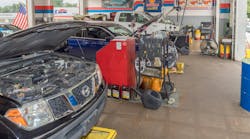What is the single biggest complaint from consumers today when it comes to being dissatisfied with a product or service they purchased? I’ll bet the answer is not too surprising to you: It’s customer service.
Yep; good old customer service. And it hardly seems to matter what business we are talking about, the complaint is almost always the same: “You just can’t get good customer service these days.”
Why is the existence of poor customer service such a universal complaint, with all we know today about what customers want, need and desire? Well, the answer to that question takes a little digging to understand.
Let’s all go back in time for a moment — back to the mid-1960s. Back then, full-service gas stations had happy, neatly dressed employees meeting you at the door of your car, washing the windshield, checking your tires and generally being “at your service,” all at no extra charge. Not only was it at no extra charge, but you also didn’t even have to ask for it. It was an automatic occurrence. Every customer got the same treatment.
That seemingly innocent era of customer service is viewed fondly in retrospect, and many of the more mature segments of our society wish that we could return to those happier, more pleasant times.
Is that an impossible task? It depends on how you view the progress that has been made in the last 40 or so years in terms of customer service.
Productivity is the overriding scorecard of business success. It stands to reason the more productive any aspect of the business is, the more dollars will be driven to the bottom line, and the more successful it will be. Based on that theory, the main area of improvement for most any business is to be more productive.
How do you increase productivity? By simply increasing the level of efficiency at each step in whatever your business process is.
A more efficient business model will generate higher productivity. There is certainly no arguing that fact. Therefore, it would only make sense that you could not make a process too efficient, for all increases in efficiency will result in higher productivity. And higher productivity is what we all want in our businesses, for sure.
Unfortunately, there is a serious flaw that has slowly and surely crept into the “higher efficiency generates higher productivity” theory, and it has created many larger inefficiencies because most don’t understand the complexities of the issue.
At its most basic level, “High efficiency generates high productivity” works well only if you make one mandatory assumption: No other single detail of the entire procedure may be changed or varied, even in the slightest manner. It is nearly impossible to make a single change within a group of procedures that have little or no effect on the remaining procedures. And this illuminates what the definition of productivity is: The sum of all the processes leading up to it. If you make a positive change in one of the many processes for any operation, the productivity will increase.
If, however, you make a positive change in one process that causes a negative change in any of the other processes, then your overall productivity will be better, but maybe not be as high as you planned.
Then again, any increase is better than stagnation, so most assume that the change was for the better and continue ahead unabated; happy, in their ignorance, that they have bettered the system. Their proof? Higher productivity, of course!
To complicate the problem a little more, the person we are using in this scenario continues to try and increase his productivity. So what does he do? More of what has been successful.
He most likely will focus on the single change he made that returned overall better results and try to become even more efficient at that single process, therefore increasing his overall productivity even more. Unfortunately, and maybe completely unknowingly, if the improvement to the one process has caused a decrease in another process, then increasing the focus on the same process as before will have an even larger negative effect on the hidden process — just as before. This all results in doing more and more work for less and less results. This is known as the Law of Diminishing Returns. There will eventually come a point when no matter how much of an improvement is made to any single process within an overall procedure, there will be no further advancements in productivity.
The Efficiency Expert
For several decades now, many businesses, big and small, have been using the efficiency expert to help them streamline and improve their overall productivity. For example, when the typical gas station owner used in the above example wanted to increase his productivity, he looked to increase his efficiency. What did he typically see as his first opportunity for improvement? Most often, it was the elimination of the happy, energetic attendant there to greet the customer at the window. How did this decision come about? Maybe he asked his customers what they valued most or what they would like to see as an improvement to the business.If his customers are like most, they would probably have said, “Lower the prices.” If someone were to ask you today if you would rather have a friendly, happy person greet you at the window, or to forgo that greeter in the hope of lower gas prices, which would you choose? And what if you could get even lower gas prices by doing away with any attendant at all and just pumping the gas yourself? Would you prefer that? Most would probably say, “yes” to that question, too.
What if you had to go inside the store to pay for the gas, because there was no attendant outside to even collect the money? Would that be a reasonable trade-off to you for even lower gas prices? And even further, how about if you can drive up, get out, pump your own gas and pay for it all at the pump with one of your credit cards, without having to have even a hint of any actual ‘human interaction’ with any of the employees? Is that a good enough collection of reasons to save a couple of pennies per gallon?
The level of efficiency has been increased every step of the way. Far fewer employees mean less payroll for the operator, resulting in lower operating costs, leading to lower, more competitive pricing structures. With no employee actually pumping the gas for the customers, the chance of damaging a customer’s car by scratching the paint with the gas nozzle or damaging the gas cap has disappeared, and the potential for liability is lower. Again, lowering operating costs overall.
Since there a reduced need for skilled gas island attendants, lower quality and lower wage earners can be employed, saving the operator even more money. With the pay-at-the-pump feature, no employee is needed for that transaction, saving the operator even more money.
All of these situations lower the operator’s costs, making the system more efficient. This, hopefully, leads to more competitive pricing for the consumer.
But none of these improvements came alone. They all had some cost associated with them. Every improvement resulted in trading-off some other aspect of the overall service.
No Free Lunch
Another way of saying this is, “there’s no free lunch.” It may appear to be free, but you are paying for it somewhere.How does this affect us in the operation of our quick lube shops? The typical lube shop owner or manager who is trying to increase his productivity will not usually make a single change in an operating system, when there are obviously several that may need improving.
No, he will tackle many areas of potential improvement just as quickly as he is able or willing to do so. Any improvement in overall productivity may signal to the manager that he is on the right track, justified by his increased results.
For example: A higher ticket is better than a lower ticket. Who will argue with that? An extra $10 per car would sure help the bottom line, right? But at what cost? We have all had technicians who have been able to sell ice to Eskimos, to put it kindly. Is getting a higher ticket, even if the customer does not actually need the item or service sold, good for business? Of course not!
Once word got out that those kinds of practices were used in your business, the slow erosion of your customer base would begin. Eventually, you would not be able to generate a high enough ticket on the few cars that still came to you for service.
What seems more reasonable to you: 50 cars a day with a $45 ticket or 20 cars a day with a $112 ticket?
Obviously, maintaining such an astronomically high ticket average would be extremely arduous, if not impossible. And would the customers keep returning? Probably not.
The Big Flaw
Examining any set of procedures for any inherent improvements is a scientific process, and that, by nature, excludes any human interaction. Any so-called improvement to a set of business procedures that does not take the human interaction into account is a fatal flaw that will lead to lower productivity, the exact opposite of the intended goal.Why is that? What most consumers say that they want and what they really want are usually two very different things.
Generally speaking, the single most important aspect that most customers want from any business transaction is to be treated with kindness, respect and professionalism. When asked what can be done to improve a business, most customers answer surveys with lower prices.
If you get any customer complaints (we all do, unfortunately), do they complain about the price? Usually they don’t. Most often, they are complaining about some aspect of the service provided to them.
In survey after survey, price is what most customers say they would want changed, yet service is what they most often complain about. If any planned improvement in your procedures takes anything away from customer service, then you should think twice about doing it.
A common example: Letting the customer fill out their personal information on your write-up sheet, while you get started on the oil change. Speeds up the service, which is more efficient, right? Not really, for you have sacrificed a miniscule portion of your customer service to make that improvement. Any improvement that lessens customer service should not be implemented, no matter how much efficiency is gained.
In your never-ending quest to increase efficiency, and to improve your productivity, never lose sight of the goal: happy customers.
As always, keep making it happen! See ya’ next month.




